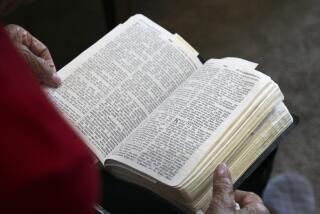Where the Secular and Biblical Canons Intersect
- Share via
“Canon” is a fighting word nowadays, a label that is applied by special pleaders in secular circles to designate the books that deserve our reverence and to distinguish them from the books that deserve our contempt. Now and then, the public intellectual brawl over “the Western canon” reaches a level of rancor so laughable that it has even been lampooned on “Saturday Night Live.”
By contrast, Robert Alter brings light rather than heat to the enterprise of defining the canon in “Canon and Creativity.” The book is a deft, graceful and illuminating contemplation of how interpretations of the Bible--among the oldest of literary forms--have, in the hands of authors who have sought to invent entirely new ones, helped us arrive at a new understanding of the canon.
He rejects the debate over the “Western canon”--a “clash of wills between writers and their masterful predecessors, assuming the model of Oedipal conflict”--and invites us to witness how a writer like the Hebrew poet Haim Nahman Bialik forges “out of the biblical materials themselves a compelling counterworld to that of the Bible.”
Alter is one of the living masters of biblical criticism and translation, a scholar whose writings have illuminated the Bible over a long and distinguished career. His “The Art of Biblical Narrative” (1981) is one of the definitive studies of the “Bible as literature”--a phrase that Alter himself refuses to embrace but one that is a useful description of his approach to the Scriptures. And his previous book, “The David Story” (1999), is a fresh translation of one of the earliest biblical texts, the Book of Samuel.
Significantly, Alter describes himself as “a critic of modern literature who has devoted considerable attention to the biblical canon,” and “Canon and Creativity” is an elegant synthesis of these two enterprises. Alter invites us to ponder the precise point of intersection where the biblical canon and the secular canon strike each other and throw off sparks, a place where we will find both the Book of Samuel and William Faulkner’s “Absalom, Absalom,” the Book of Genesis and Franz Kafka’s “Amerika,” the Song of Songs and James Joyce’s “Ulysses.”
Alter points out that the very idea of a canon has come full circle. First used among Hellenistic grammarians of antiquity to designate the required reading for an educated person, it has come to mean, as Alter writes, “the corpus of secular literary works implicitly or explicitly endorsed by established cultural authority as worthy of preservation through reading and study.” In between, however, “the canon” referred to the collection of ancient writings that had been recognized as Holy Writ by the church fathers and the Talmudic sages, and that’s where the term acquired its cutting edge: Canonization is the process by which we are told what’s in and what’s out.
Intriguingly, Alter emphasizes that the canonization of texts is not always a tool of censorship. Both the Song of Songs, with its erotic love poetry, and the Book of Ecclesiastes, with its fatalism and world-weariness, were embraced by the Rabbinic sages who canonized the Hebrew Bible. “Ideological consensus among the makers of the Jewish canon was less a matter of party-line agreement than one might imagine,” Alter suggests, and “the canon makers were willing to tolerate a certain spectrum of outlooks.” Not surprisingly, the traditional biblical canon finds expression in some of the most revolutionary works of high modernism.
Indeed, the very notion of “canonicity” achieves a kind of critical mass when the Bible is injected into the work of poets and writers of a purely secular cast of mind. Thus, for example, Alter goes in search of biblical influences in the writings of “a disruptive modernist” like Kafka, and finds what he calls a “fantastic fusion of Genesis and Exodus with a contemporary New York and Oklahoma” in the novel published under the title “Amerika.” And Alter argues that the Bible is just as crucial as the works of Homer in decoding Joyce’s “Ulysses.”
“Joyce conceives the Bible and the Odyssey as the two great narratives of origin and the two great models for the trajectory of moral life in our cultural tradition,” Alter says. “In his view, everything ultimately derives from these two founding texts.”
At its best, modern biblical scholarship invites us to read the Bible in new, surprising and enlightening ways, thus prompting us to open a book that has always been the least-read bestseller in Western history. That’s exactly what makes the work of modern Bible critics such as Jack Miles, Karen Armstrong, Richard Elliot Friedman, Donald Harman Akenson, Harold Bloom and David Rosenberg so rich, so provocative and so rewarding. With “Canon and Creativity,” Alter, the dean of them all, reminds us exactly why the Bible is as lively and meaningful today as it was when its earliest passages were first set down on parchment 3,000 years ago.
Jonathan Kirsch is the author of “The Harlot by the Side of the Road” and, most recently, “King David: The Real Life of the Man Who Ruled Israel.”
More to Read
Sign up for our Book Club newsletter
Get the latest news, events and more from the Los Angeles Times Book Club, and help us get L.A. reading and talking.
You may occasionally receive promotional content from the Los Angeles Times.









